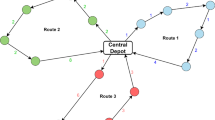Abstract
In tandem AGV systems, the shop floor is partitioned into a group of non-overlapping zones, where each is served by a single dedicated vehicle. In this paper, a two phase algorithm for partitioning tandem AGV systems is proposed. The proposed algorithm serves a number of objectives including minimizing the total handling cost, minimizing the maximum workload in the system and minimizing the number of between-zones trips. The algorithm is equipped with parameters to enable the user to select one of these objectives or to optimize a combination of them. The performance of the algorithm regarding the objective of minimizing the material handling cost is evaluated by experimental design. The experiment is based on comparing the solutions obtained by the proposed algorithm with best solutions obtained by a ‘rationalized exhaustive enumeration’ procedure for a group of randomly generated problems. The analytical results showed that the proposed algorithm obtains an average of 99.53% efficiency, and that none of the considered factors has a main significant effect on the performance of the algorithm in regards to the objective of minimizing the total material handling cost, however, a few of the interaction effects are significant.
Similar content being viewed by others
References
Bozer YA, Srinivasan MM (1989) Tandem configuration for AGV systems offer simplicity and flexibility. Industr Eng 21(2):23–27
Bozer YA, Srinivasan MM (1992) Tandem AGV systems: A partitioning algorithm and performance comparison with conventional AGV systems. Eur J Oper Res 63(2):173–191
Bozer YA, Srinivasan MM (1991) Tandem configurations for automated guided vehicle systems and the analysis of single vehicle loops. IIE Trans 23(1):72–82
Hsieh L–F, Sha DY (1996) A design process for tandem automated guided vehicle systems: the concurrent design of machine layout and guided vehicle routes in tandem automated guided vehicle systems. Integrat Manuf Sys 7(6):30–38
Yu W, Egbelu, PJ (2001) Design of a Variable Path Tandem Layout for Automated Guided Vehicle Systems. J Manuf Syst 20(5):305–319
Kim KS, Chung BD, Jae M (2003) A design for a tandem AGVS with multi-load AGVs. Int J Adv Manuf Tech 22 (9):744–752
Rajotia S, Shanker K, Batra, JL (1998) Determination of optimal AGV fleet size for an FMS. Int J Prod Res 36(5):1177–1198
Montgomery DC (1997) Design and analysis of experiments, 4th edn. Wiley, New York
Author information
Authors and Affiliations
Corresponding author
Rights and permissions
About this article
Cite this article
Shalaby, M.A., Elmekkawy, T.Y. & Fahmy, S.A. A cost based evaluation of a zones formation algorithm in tandem AGV systems. Int J Adv Manuf Technol 31, 175–187 (2006). https://doi.org/10.1007/s00170-005-0163-1
Received:
Accepted:
Published:
Issue Date:
DOI: https://doi.org/10.1007/s00170-005-0163-1




